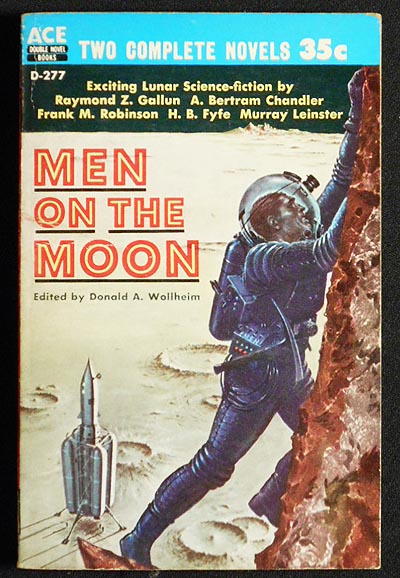"Men on the Moon" ed. by Donald A. Wollheim
The lunar theme continues with the anthology Men on the Moon. Consider that all these stories were written long before Neil Armstrong and Buzz Aldrin stepped onto the moon, and that for me, the lunar landing was (recent) history when I was born. These are true science fiction stories of their day, hypothesizing how certain physics and concepts would work, mostly with reasonable accuracy.
The Ace Double version was published in 1958, and the Men on the Moon anthology republished by Ace in 1969 with cover art by Gary Morrow. Page count was boosted to 192 from the original 137; the new edition benefitting from a new post moon-landing introduction and a lengthy non-fiction section with essays by Donald A. Wollheim, Isaac Asimov, John Brunner, Ray Bradbury, Poul Anderson, Michael Moorcock, Frederik Pohl, Murray Leinster, and nearly two dozen others.
Raymond Z Gallun’s “Operation Pumice” was first published in Thrilling Wonder Stories, April 1949, and reprinted twice (in 1951 & 1952) in the Possible Worlds of Science Fiction anthology, with cover art by E. B. Mudge-Marriott. As the oldest story in the collection, it shows its age with a pulpier take on how a rocket would orbit the moon. Even so, the various aspects of multi-stage rockets are in place.
What gave me a chuckle was the main character, Mel Robbins, struggling to write a note with his pen in space – reminiscent of the legend of NASA spending millions developing a ball point pen that would work in space, while the Russians already had a solution, a pencil.
I could take or leave this story. It was more about inspiration and striving for the stars than orbiting the moon, which seemed to be an almost incidental event.
A Bertram Chandler’s “Jetsam” was first published in New Worlds of Science Fiction, March 1953 with cover art by Bob Clothier, and in The Magazine of Fantasy and Science Fiction the following month. It has seen publication in various anthologies since, and most recently resurfaced in 1950s Tales from Outer Space, published by Lost Science Fiction.
This story in some ways ties in with a theme in Four from Planet 5. It involves a true lunar landing, some commentary on how military requirements can hijack science and a startling discovery, with a not so subtle warning about cold war politics. I enjoyed it even though the theme has been seen before – or perhaps more correctly, since.
Frank M Robinson’s “Reluctant Heroes” first saw publication in the January 1951 issue of Galaxy Science Fiction Stories, with cover art by John Bunch. It was subsequently published a year later in the Galaxy Reader of Science Fiction anthology. It saw publication in further anthologies during the 1960’s, and appears to have last been published in 1981 by Bantam Books collection: A Day in the Life of… and Other Short Stories, with a David Perry cover.
This story lives up to its title. In some ways one could liken it to the short story “Red Star, Winter Orbit” by Bruce Sterling and William Gibson. An enjoyable piece about the sacrifices some have to, oft unwillingly, make for the good of all. It also allows one to crack a smile about the usage of certain outmoded technologies, which the writer clearly had not considered or anticipated at the time. Something M Harold Page discussed in an earlier blog entry.
Space Science Fiction, November 1952 edited by none other than Lester del Rey, published HB Fyfe’s “Moonwalk.” The story saw re-publication in the likes of Fawcett Gold Medal’s Worlds to Come (edited by Damon Knight) and most recently in the 2012 reprint of Space Pioneers edited by Andre Norton. This story must be popular as, barring a two decade hiatus in the 1980’s and 1990’s, it has pretty much remained in print.
This is the longest story in the anthology, weighing in at 53 pages. Technically it may be considered a novella, or perhaps a novelette if my estimation of word count is correct. The story is well paced and intriguing. A triumph-of-the-will type story, which was inspirational in terms of the hardships that one may endure. The odd contrast I drew to Murray Leinster’s style was that those characters even with minor parts still had a name, which gave a close, almost family feel to interactions.
Murray Leinster’s “Keyhole” is the final short story in the anthology and is by far the most popular, having remained in print ever since its initial publication in Thrilling Wonder Stories, December 1951, with the most recent version being in Alien Stories 1 by Oxford University Press.
This is a clever tale that blurred the line between science fiction and fantasy. It has some philosophical tones in terms of what we as human beings consider to be sentient and worth preserving. This story holds a special memory for me as the power utility in my home country, through poor planning, had a series of blackouts, and this was the story I read to my wife by candle light to while away the time.


Comments
Post a Comment